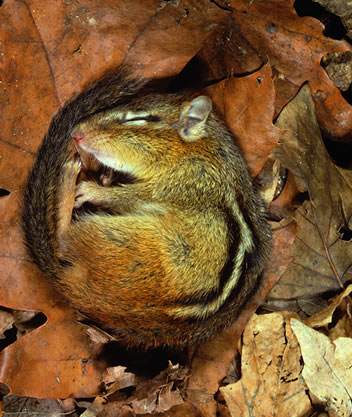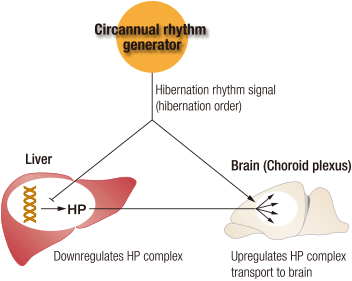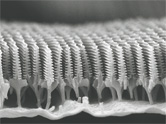
An attempt to adapt animals’ bio mechanisms to serve human needs is also underway. Hibernation enables several species of animals to survive cold winters when food is scarce. Poikilotherms, cold-blooded animals such as snakes, frogs and turtles, hibernate, and so do some homeotherms, mammals such as squirrels and bats. If humans could hibernate, we might be able to cure diseases, slow the aging process and facilitate interplanetary travel.
What is hibernation?
Scientists have struggled to define mammals’ hibernation, because factors such as its duration and changes in body temperature and heartbeat rate vary depending on each species. One of the researchers tackling the intricacies of mammals’ hibernation mechanisms is Dr. Noriaki Kondo, a special fellow at Tamagawa University in Tokyo who has studied the phenomenon for more than 30 years.
“During hibernation, the body temperature drops and the heartbeat and breath slow down drastically,” explains Dr. Kondo, who uses chipmunks in his research. “When chipmunks hibernate, their metabolism decreases to one-fiftieth of what it is when they are active, and their body temperature drops to 5°C (41°F). They look as if they have frozen to death. However, by observing inside the chipmunk’s body, you can see that it is alive.”

The hibernation mechanism based on Dr. Kondo’s research: A circannual rhythm generator transmits a signal to different parts of the body, including the liver and the brain, to trigger hibernation. While the HP complex is downregulated in the liver, its transport to the choroid plexus in the brain is upregulated. The HP complex is activated in the brain and transforms into a “hibernation hormone.”
Reference: Tomin no nazo wo toku (Unraveling the mystery of hibernation), a book by Dr. Noriaki Kondo, published as a part of the Iwanami Shinsho series
Perhaps most compelling, hibernation seems to enhance tolerance to disease; muscles and bones do not degenerate, and the brain continues to function despite low intake of oxygen and nutrients. Dr. Kondo believes that hibernation may even be a time when tissues are being repaired.
But what triggers hibernation? Is it a “biological clock”? Is it temperature? Studying chipmunks, Dr. Kondo discovered it is the hibernation-specific protein (HP) complex, a combination of four proteins produced in the liver. When a chipmunk is active, HP complex circulates throughout its body in the bloodstream. During hibernation, the level of HP complex decreases in the blood and increases in the brain. Dr. Kondo believes that the HP complex may function like a hormone to regulate the body so it can endure low temperatures during hibernation.
Mission to Mars … and beyond
It’s a popular science-fiction scenario: The crew of a spaceship emerges from hibernation as they approach a distant planet. If researchers have their way, this will become science fact, and humans will be able to travel millions of miles into space.
NASA is planning a round-trip flight to Mars in the 2030s, a trip that could take up to a year and a half, and the ability to hibernate to some degree during such a protracted journey would be extremely useful. “In space, bone density decreases and muscles deteriorate, just as if you were bedridden,” explains Dr. Noriaki Ishioka, a professor of space life science at the Japanese Aerospace Exploration Agency’s (JAXA) Institute of Space and Astronautical Science. “If we could biologically control astronauts so that they can hibernate — to maintain bone and muscle mass — it would make a significant difference. It would save food, oxygen and some energy too. What’s more, it might also benefit our life on Earth, such as by preventing or even curing osteoporosis.”
Dr. Kondo adds that humans do possess a protein similar to the HP complex that controls the immune system and metabolism. In fact, there are two documented cases of possible “human hibernation.” A Japanese man survived 24 days after a fall while climbing Mount Rokko in western Japan, in 2006. When he was rescued, his body temperature was only 22°C (77°F). In Sweden in 2012, a man survived for two months in a snow-covered car. Doctors conjectured his body might have entered a “bear-like hibernation mode.”
Dr. Ishioka is investigating the feasibility of human hibernation. “Experiments on Earth are inevitably affected by gravity,” he says. In March 2013, joined by Dr. Akihiko Ishihara of Kyoto University, he took hibernating homeotherms, including chipmunks, on an airplane that simulated microgravity through parabolic flight, and observed changes in their metabolism at low temperatures. He is also collecting and analyzing data from animal experiments conducted in outer space, such as genetic changes in mice that have lived 90 days in a space environment.
“Our ultimate goal,” he says, “is to conduct hibernation experiments with animals aboard the International Space Station. We may be able to discover the key to human hibernation by conducting experiments in microgravity conditions. I hope to find a way to apply this in space exploration and also to enrich our life on Earth. I want to transform science fiction into reality.”
Becoming one with nature
Humans are part of nature, so it makes sense that we should never stop trying to learn from the natural world — including specialized functions in plants and animals that could lead to groundbreaking solutions in energy, the environment and health. With scientists committing themselves to such endeavors around the world and making new discoveries and advances at an increasing pace, we can hope for our lives to become increasingly enhanced, while protecting Earth and promoting its longevity.
-

Nikon pursues structural colors

A Morpho butterfly and a structural color sample.Nikon is also learning from different organisms, in its research and development work on structural colors.
Structural colors are not produced by pigments. Instead, the bright, metallic coloration results from unique structures that interact with light. It occurs in nature, as on the wings of Morpho butterflies and jewel beetles.
Microscopic scales on the backs of Morpho butterflies’ wings create a vivid, iridescent blue coloring. The scales have numerous arrays of ridges that are spaced approximately 700 nanometers apart; each ridge has multiple lamellae that are positioned approximately 130 nanometers away from each other. These lamellae are arranged at irregular heights. They appear to form a fragmented multilayer structure.
Multilayer interference occurs when incoming light hits this intricate structure, whose dimensions are on the scale of light wavelengths. Light in the blue wavelength range, which matches the interference conditions of the structure, is amplified and reflected in this process, resulting in the blue metallic appearance of the wings. Furthermore, lamellae, the widths of which are smaller than the blue light wavelength, diffract this interfered light, and reflect it at a wider angle. Black pigments beneath the lamellae absorb light wavelengths other than blue, enhancing the reflection of blue light only.
These complex mechanisms all contribute to Morpho butterflies’ ability to radiate a color that is impossible for pigments alone to produce.

A cross-section of a scale on a Morpho butterfly’s wing reveals the lamellae (scanning electronic microscope image, at 10,000x magnification).Structural colors remain constant as long as the structure that produces them is kept intact. Mimicking such a mechanism, it may be possible to develop excellent coloring materials that will never fade. This would eliminate painting and dyeing processes, eventually contributing to energy conservation and the reduction of industrial waste.
Nikon continues to explore structural colors and their mechanisms, and is developing applications for their practical use. The goal is to create innovative coatings of unprecedented, beautiful colors and textures to apply to our products, and invent highly specialized optical elements. Inspired by the promise of such products, Nikon is determined to continue its exacting research of structural colors.
- 1. Plant power: tapping into truly green energy
- 2. Biomimetics: recreating structures found in nature
- 3. Hibernation: the possibility of a longer lifespan

